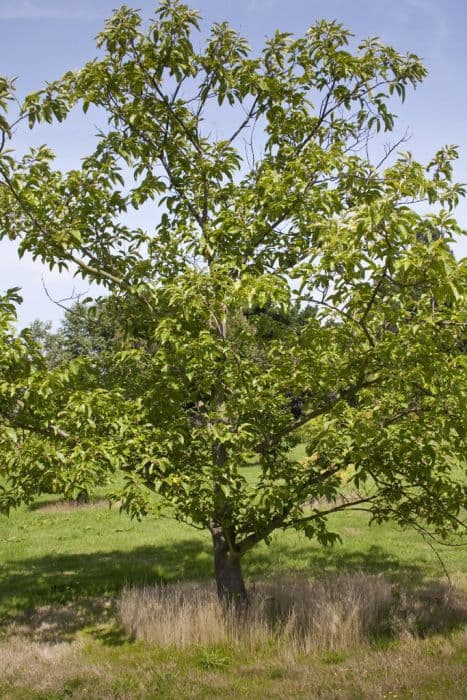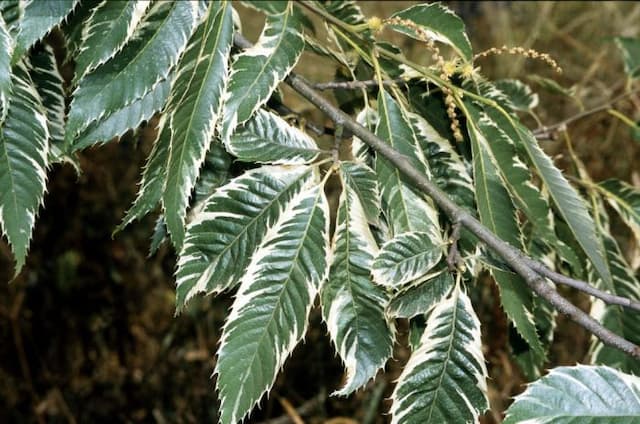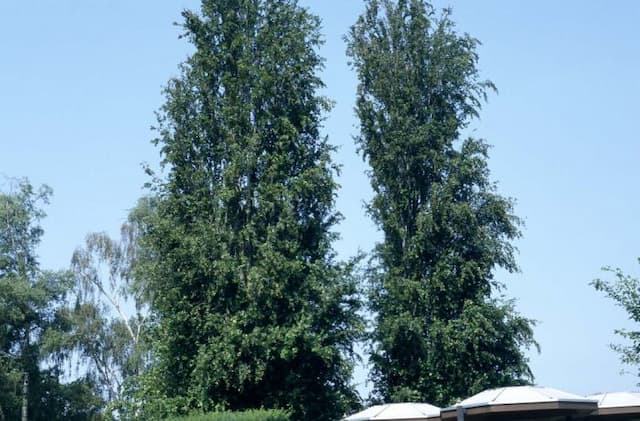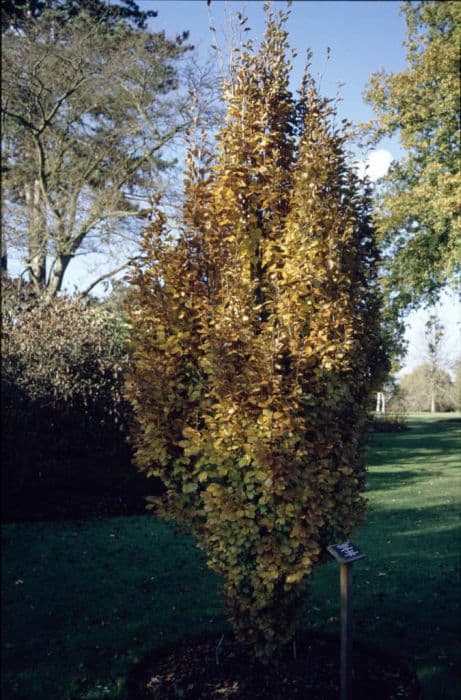Rohan Beech Fagus sylvatica 'Rohanii'

ABOUT
The Fagus sylvatica 'Rohanii', commonly known as the European beech 'Rohanii', has distinctive foliage that makes it a standout ornamental tree. The leaves of 'Rohanii' are deeply lobed, almost feather-like in their appearance, reminiscent of an oak leaf structure. They emerge in spring with a rich purple color, creating a striking contrast against the landscape. As the season progresses, the leaves can transform to a purplish-green shade, adding a sense of depth and dynamic color change to its presence. In the fall, the foliage changes again, presenting a beautiful coppery hue before the leaves are shed. Aside from its vibrant foliage, the plant has a smooth, silver-gray bark that provides visual interest throughout the year, particularly in the winter when the branches are bare. The European beech 'Rohanii' produces inconspicuous flowers in the spring, which are followed by small, triangular nuts encased in a prickly husk, known as beechnuts. These are not only decorative but also provide food for wildlife. Overall, the European beech 'Rohanii' is treasured for its elegant leaf shape and seasonal color variation, which breathes life into gardens and landscapes across the seasons. With its sophisticated appearance and attractive bark, it is a desirable choice for adding texture and color to ornamental plantings.
About this plant
 Names
NamesSynonyms
Rohan Beech, Rohan European Beech.
Common names
Fagus sylvatica 'Rohanii'
 Toxicity
ToxicityTo humans
The European beech (Fagus sylvatica 'Rohanii') is generally not considered toxic to humans. However, eating large quantities of the seeds, leaves, or bark could potentially cause stomach upset due to the presence of tannins and other compounds. It is always advisable to avoid ingesting parts of ornamental plants due to possible individual allergies or unknown reactions.
To pets
The European beech is generally not regarded as toxic to pets. Similarly to humans, if pets ingest large quantities of the seeds, leaves, or bark, they might experience gastrointestinal discomfort or upset due to the tannins and other compounds present in the plant. It is always prudent to prevent pets from consuming plant material, especially in large amounts, to avoid any potential health issues.
 Characteristics
CharacteristicsLife cycle
Perennials
Foliage type
Deciduous
Color of leaves
Purple
Height
50 70 feet (15-21 meters)
Spread
35 50 feet (10.5-15 meters)
Plant type
Tree
Hardiness zones
4
Native area
Europe
Benefits
 General Benefits
General Benefits- Aesthetic Appeal: Fagus sylvatica 'Rohanii', commonly known as the 'Rohanii' European Beech, adds visual interest to landscapes with its unique, crinkled burgundy leaves and distinctive fall color.
- Shade Provider: Due to its dense canopy, it offers considerable shade in gardens and parks, making it a great choice for creating cool, shaded areas during warmer months.
- Wildlife Habitat: The tree provides habitat and food for various wildlife species, including birds and squirrels which rely on its nuts for sustenance.
- Carbon Sequestration: Like other trees, the 'Rohanii' European Beech absorbs carbon dioxide from the atmosphere, helping to mitigate the impact of climate change.
- Privacy and Noise Reduction: Its thick foliage can act as a natural privacy screen and sound barrier, making it useful for planting along property lines or near busy streets.
- Soil Stability: The robust root system of the 'Rohanii' European Beech helps to stabilize soil and prevent erosion on slopes and in areas susceptible to soil degradation.
- Hardiness: It is a resilient tree that can thrive in a variety of soil types and withstand harsh climates, which makes it a low-maintenance choice for many landscapes.
 Medical Properties
Medical PropertiesThis plant is not used for medical purposes.
 Air-purifying Qualities
Air-purifying QualitiesThis plant is not specifically known for air purifying qualities.
 Other Uses
Other Uses- The deep purple foliage of the European Beech 'Rohanii' can be used as a natural dye for textiles, imparting a range of purple to gray hues depending on the mordant used.
- Woodworkers may utilize small branches and twigs from pruning for crafting unique jewelry or ornamental objects, capitalizing on the wood's density and fine grain.
- Leaves from the European Beech 'Rohanii' can be pressed and used in botanical art or herbarium collections for educational or decorative purposes.
- Due to its dense foliage, the European Beech 'Rohanii' can be incorporated into outdoor sound barrier designs to help reduce noise pollution in gardens and landscapes.
- The tree's striking appearance makes it a popular choice for bonsai, allowing enthusiasts to create miniature landscapes with its striking foliage color.
- The thick canopy of the 'Rohanii' can provide habitat and support for climbing plants, creating a living trellis in a garden setting.
- Wood shavings and sawdust resulting from the tree's maintenance can be used as mulch in gardens, providing soil enrichment and weed control while decomposing.
- European Beech 'Rohanii' can be used in photography and film as a backdrop for outdoor scenes, providing a rich color contrast and enhancing visual interest.
- Fallen leaves from the European Beech 'Rohanii' can be collected and used to create a natural leaf mold, which is an excellent soil conditioner for garden beds.
- In forestry education, the European Beech 'Rohanii' serves as an example of variation within species, showing how selective breeding can lead to distinct cultivars with unique attributes.
Interesting Facts
 Feng Shui
Feng ShuiThe European Beech is not used in Feng Shui practice.
 Zodiac Sign Compitability
Zodiac Sign CompitabilityThe European Beech is not used in astrology practice.
 Plant Symbolism
Plant Symbolism- Endurance and Strength: Fagus sylvatica 'Rohanii', commonly known as the European beech, often symbolizes endurance and strength due to its hard wood and longevity.
- Wisdom and Learning: The European beech has traditionally been associated with wisdom and learning, as beech wood was historically used for writing tablets.
- Patience: Given the slow growth of the beech tree, it represents patience, highlighting the tree's gradual development and maturation over time.
- Prosperity and Abundance: Beech mast, the tree's nuts, have been a source of food for wildlife, symbolizing a time of prosperity and abundance.
- Nobility: With its grand stature and presence, the European beech has been seen as a symbol of nobility and grace in various cultures.
 Water
WaterThe European Beech 'Rohanii' prefers consistent moisture but does not like to be waterlogged. Water the plant deeply once a week, providing around 1 to 1.5 gallons for young trees and 2 to 3 gallons for established trees, depending on the size and weather conditions. During hot, dry periods, increase the frequency of watering but ensure that the soil has time to dry out slightly between sessions. For mature trees, a deep watering every two to three weeks may suffice, allowing the water to penetrate several inches into the soil around the root zone.
 Light
LightThe European Beech 'Rohanii', thrives in full sun to partial shade. It is adaptable to a range of light conditions but develops the best foliage color in a spot where it receives sunlight for at least part of the day. An ideal location would provide morning sun with some afternoon dappled shade, especially in hotter climates.
 Temperature
TemperatureFor the European Beech 'Rohanii', the best temperature range is between 50°F and 75°F. It can tolerate winter lows down to about -30°F once established, demonstrating considerable cold hardiness. The maximum temperature should generally not exceed 85°F to 90°F, particularly in regions with high humidity.
 Pruning
PruningPrune the European Beech 'Rohanii' to maintain its shape and health, removing any dead or crossing branches. The best time for pruning is in late winter or early spring before the new leaves emerge. Occasional thinning of the canopy helps to increase airflow and light penetration, enhancing the tree's overall vigor. The frequency of pruning depends on the growth rate; inspect the tree annually and prune as needed.
 Cleaning
CleaningAs needed
 Soil
SoilThe European beech 'Rohanii' thrives in well-draining, fertile loam with a slightly acidic to neutral pH of about 5.0-7.0. A mix of garden soil, compost, and leaf mold or peat moss can provide the nutrients and structure required for healthy growth.
 Repotting
RepottingEuropean beech 'Rohanii' generally does not need frequent repotting and can be done every 3-5 years as the tree grows slowly or as necessary to refresh the soil.
 Humidity & Misting
Humidity & MistingEuropean beech 'Rohanii' prefers moderate humidity levels but is adaptable to the average outdoor humidity where it grows naturally and does not require specific humidity adjustments when planted in its ideal outdoor environment.
 Suitable locations
Suitable locationsIndoor
Not suitable for indoor growth; requires outdoor conditions.
Outdoor
Plant in well-drained soil, partial to full sun, and shelter from strong winds.
Hardiness zone
4-7 USDA
 Life cycle
Life cycleFagus sylvatica 'Rohanii', commonly known as European beech 'Rohanii', begins its life cycle through seed germination, which occurs in spring following stratification during the winter months. Seedlings develop into juvenile trees, showing distinctive purple foliage, and continue to grow over several years, gradually establishing a robust root system. As it matures, the European beech 'Rohanii' enters its reproductive phase, characterized by the development of both male and female flowers in early spring, which after pollination, lead to the production of beechnuts. These nuts are either dispersed by wildlife or gravity, giving rise to new seedlings, thereby continuing the cycle. The tree reaches its full maturity in several decades, during which the canopy spreads and the trunk thickens significantly. European beech 'Rohanii' has a lifespan that may extend beyond 150 years, after which the tree may gradually decline and eventually die, returning nutrients to the soil, thus supporting the growth of new plant life.
 Propogation
PropogationPropogation time
Late winter to early spring
The European beech 'Rohanii', known for its attractive purple foliage, is typically propagated by grafting, which is the most popular method used for this cultivar. The optimal time for grafting is late winter before the sap starts to flow, which typically occurs around late February to early March. In the process, a scion of 'Rohanii' is taken, usually comprising one-year-old wood with a couple of buds, and is grafted onto a rootstock of the common beech. The scion is carefully spliced onto a prepared notch or cut in the rootstock, ensuring good cambial contact between the two. The junction is then securely wrapped to promote successful grafting and prevent drying out. This union needs to be kept in a moisture-controlled environment until the graft has taken, usually by the start of the growing season. Grafting offers the advantage of reproducing the exact characteristics of 'Rohanii', something that seed propagation cannot guarantee due to genetic variability.









